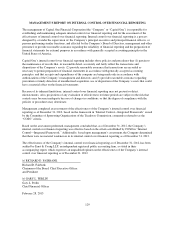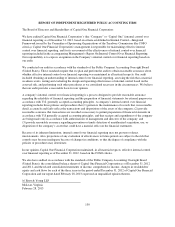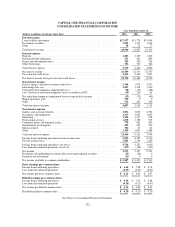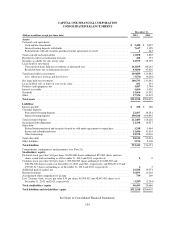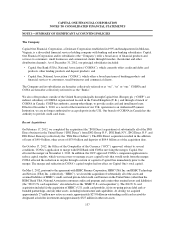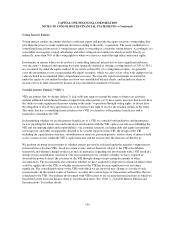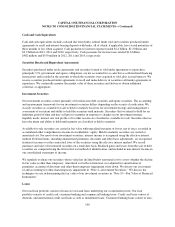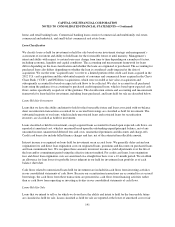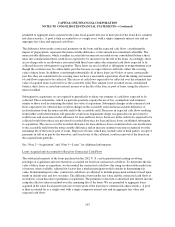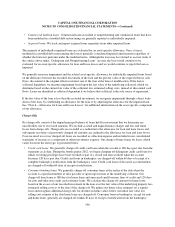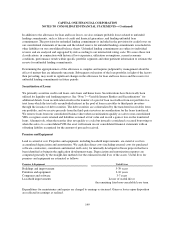Capital One 2012 Annual Report Download - page 158
Download and view the complete annual report
Please find page 158 of the 2012 Capital One annual report below. You can navigate through the pages in the report by either clicking on the pages listed below, or by using the keyword search tool below to find specific information within the annual report.CAPITAL ONE FINANCIAL CORPORATION
NOTES TO CONSOLIDATED FINANCIAL STATEMENTS—(Continued)
Voting Interest Entities
Voting interest entities are entities that have sufficient equity and provide the equity investors voting rights that
give them the power to make significant decisions relating to the entity’s operations. The usual condition for a
controlling financial interest in a voting interest entity is ownership of a majority voting interest. Accordingly, we
consolidate our majority-owned subsidiaries and other voting interest entities in which we hold, directly or
indirectly, more than 50% of the voting rights or where we exercise control through other contractual rights.
Investments in entities where we do not have a controlling financial interest but we have significant influence
over the entity’s financial and operating decisions (generally defined as owning a voting interest of 20% to 50%)
are accounted for under the equity method. If we own less than 20% of a voting interest entity, we generally
carry the investment at cost, except marketable equity securities, which we carry at fair value with changes in fair
value included in accumulated other comprehensive income. We typically report investments accounted for
under the equity or cost method in other assets on our consolidated balance sheets, and include our share of
income or loss in other non-interest income in our consolidated statements of income.
Variable Interest Entities (“VIEs”)
VIEs are entities that, by design, either (1) lack sufficient equity to permit the entity to finance its activities
without additional subordinated financial support from other parties, or (2) have equity investors that do not have
the ability to make significant decisions relating to the entity’s operations through voting rights, or do not have
the obligation to absorb the expected losses, or do not have the right to receive the residual returns of the entity.
The entity that has a controlling financial interest in a VIE is referred to as the primary beneficiary and is
required to consolidate the VIE.
In determining whether we are the primary beneficiary of a VIE, we consider both qualitative and quantitative
factors regarding the nature, size and form of our involvement with the VIE, such as our role in establishing the
VIE and our ongoing rights and responsibilities; our economic interests, including debt and equity investments,
servicing fees, and other arrangements deemed to be variable interests in the VIE; the design of the VIE,
including the capitalization structure, subordination of interests, payment priority, relative share of interests held
across various classes within the VIE’s capital structure and the reasons why the interests are held by us.
We perform on-going reassessments of whether entities previously evaluated under the majority voting-interest
framework have become VIEs, based on certain events, and are therefore subject to the VIE consolidation
framework and whether changes in the facts and circumstances regarding our involvement with a VIE result in a
change in our consolidation conclusion. Our reassessment process considers whether we have acquired or
divested the power to direct the activities of the VIE through changes in governing documents or other
circumstances. The reassessment also considers whether we have acquired or disposed of a financial interest that
could be significant to the VIE, or whether an interest in the VIE has become significant or is no longer
significant. The consolidation status of the VIEs with which we are involved may change as a result of such
reassessments. In the normal course of business, we enter into various types of transactions with entities that are
considered to be VIEs. Our primary involvement with VIEs relates to our securitization transactions in which we
transferred assets from our balance sheet to securitization trusts. See “Note 7—Variable Interest Entities and
Securitizations” for further details.
139


